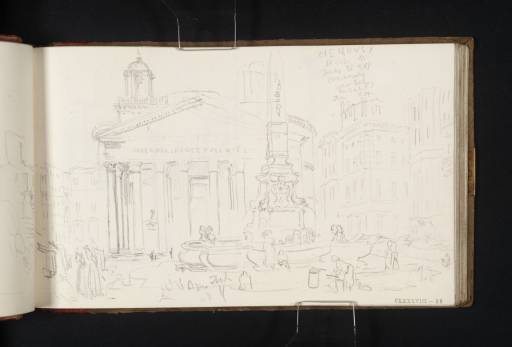Joseph Mallord William Turner Fountain in the Piazza della Rotonda, Rome, with the Portico of the Pantheon Beyond 1819
Joseph Mallord William Turner,
Fountain in the Piazza della Rotonda, Rome, with the Portico of the Pantheon Beyond
1819
Joseph Mallord William Turner 1775–1851
Folio 29 Recto:
Fountain in the Piazza della Rotonda, Rome, with the Portico of the Pantheon Beyond 1819
D16208
Turner Bequest CLXXXVIII 28
Turner Bequest CLXXXVIII 28
Pencil on white wove paper, 114 x 189 mm
Inscribed by the artist in pencil ‘CLEMENS X | Pont M | Fontis Et Fori | Ornamento | ano Sal MDCCXI | Pon XIX’ top left and ‘MAGRIPPA LFCOSTEPPIVM IEC’ across façade of Pantheon. Also ‘Fish’ below sketch of basin of fountain
Stamped in black ‘CLXXXVIII 28’ bottom right
Stamped in black ‘CLXXXVIII 28’ bottom right
Accepted by the nation as part of the Turner Bequest 1856
References
1909
A.J. Finberg, A Complete Inventory of the Drawings of the Turner Bequest, London 1909, vol.I, p.559, as ‘Fountain in the Piazza della Rotonda, with the portico of the Pantheon beyond’.
1984
Cecilia Powell, ‘Turner on Classic Ground: His Visits to Central and Southern Italy and Related Paintings and Drawings’, unpublished Ph.D thesis, Courtauld Institute of Art, University of London 1984, pp.117, 121, reproduced pl.59, as ‘The Pantheon’.
1987
Cecilia Powell, Turner in the South: Rome, Naples, Florence, New Haven and London 1987, pp.[43], 48, reproduced p.[43] pl.51, as ‘The façade of the Pantheon’.
1990
David Blayney Brown, The Art of J.M.W. Turner, London 1990, reproduced p.162, as ‘The Pantheon’.
1997
Inge Herold, Turner on Tour, Munich and New York 1997, p.51, reproduced p.48, as ‘The Façade of the Pantheon, St Peter’s sketchbook’.
1996
Chloe Chard, ‘Crossing Boundaries and Exceeding Limits: Destabilization, Tourism, and the Sublime’, in Chloe Chard and Helen Langdon (eds.), Transports: Travel, Pleasure, and Imaginative Geography, 1600–1830, New Haven and London 1996, reproduced fig.45, p.141, as ‘The Façade of the Pantheon’.
The Pantheon is the oldest surviving domed structure in Rome and one of the city’s most famous buildings. Once an ancient temple, it was later consecrated as a Christian church, an event which helped to ensure its preservation. It is also the site of some important tombs including those of the painters Annibale Carracci and Raphael. Turner has depicted the building from the front, with the famous coffered ceiling only just visible beyond the portico. The bell-tower s on either side of the pediment were erected by Bernini. They were commonly known by the derogatory name of the ‘le orrechie d’asino’ (ears of the ass) and were taken down during the late nineteenth century. Turner’s transcription of the Latin text running along the frieze of the portico is not quite accurate. It should read: ‘M.AGRIPPA.L.F.COS.TERTIVM. FECIT’ (Marcus Agrippa, son of Lucius, consul for the third time, made it). Cecilia Powell has noted that this is a composite view.1 Turner has drawn the roof of the Pantheon as visible on both sides of the façade. This is a visual impossibility and means he must have altered his viewpoint during the sketch. She also notes that Turner has sketched an outline of the composition faintly first before working over parts of the drawing with firmer lines.2
The foreground of the sketch is dominated by the fountain which stands near the Pantheon in the Piazza della Rotonda. The basin of the fountain was built in the sixteenth century by Giacomo della Porta but the structure was completed in 1711 when Pope Clement XI added an ancient Egyptian obelisk. At the top right-hand side of the page, Turner has transcribed the inscription commemorating this event from the fountain base into which the obelisk is set. However, Turner’s record of the text is not quite accurate and it ought to read ‘CLEMENS XI | PONT.MAX. | FONTIS ET FORI | ORNAMENTO | ANNO SAL | MDCCXI | PONTIF.XI’. His other annotation on this page, ‘Fish’ refers to the decorative sculptures of the fountain designed by Filippo Barigioni which include dolphins, shells, fish and large figurative masks spouting water.
A small part of the left-hand side of the view spills over onto the opposite sheet of the double-page spread, see folio 28 verso (D16208; Turner Bequest CLXXXVIII 27a). Further sketches of the Pantheon can be found on folios 30 (D16209; Turner Bequest CLXXXVIII 29), folio 65 (D16272; Turner Bequest CLXXXVIII 64) and folio 65 verso (D16273; Turner Bequest CLXXXVIII 64a).
Verso:
Blank
Nicola Moorby
September 2008
How to cite
Nicola Moorby, ‘Fountain in the Piazza della Rotonda, Rome, with the Portico of the Pantheon Beyond 1819 by Joseph Mallord William Turner’, catalogue entry, September 2008, in David Blayney Brown (ed.), J.M.W. Turner: Sketchbooks, Drawings and Watercolours, Tate Research Publication, December 2012, https://www

